Nearly two decades after the landmark series appeared, David Lapham’s Stray Bullets has lost none of its brutal, heartbreaking power.
A quick look at the new titles that hit the stands in 1995 reveals a panoply of goodies, ranging from Amazing X-Men to Astonishing X-Men, and from X-Caliber to Gambit and the X-Ternals. And that was just Marvel! Strangely, around that time I found myself devoting more of my comics energy to the UK small press scene…
Anyway, luckily for us, writer/artist David Lapham and his wife Maria were sitting down at their kitchen table and hatching El Capitan Books, a self-publishing vehicle for a black-and-white crime comic entitled Stray Bullets.
By taking the risky step of leaving the protective custody of Big Publishing to tell the stories he wanted to tell, Lapham laid at least some of the foundations for the creator-owned variety we’re enjoying at the moment.
Over 10 years and 40 issues, Lapham’s gripping, brutal and heartbreaking stories hoovered up critical acclaim and awards, and heralded a new generation of noirish, morally ambiguous, character-led crime comics.
Even though it’s nearly a decade since the series came to a halt (with the cliffhanger of #40), the dormant enthusiasm for Lapham’s masterwork was roused with a vengeance last December, when Image’s early Christmas present was the announcement that not only would the original series be completed, with the long-awaited #41, but there’d also be a new title – Stray Bullets: Killers.
And, while it’s nearly two decades since the original title appeared, the debut issue of Killers makes it clear that Lapham has lost none of his capacity to drive the wind out of his readers with an emotional body blow.
Harking back to the stunning #2 of the original series, ‘Victimology’, which introduced long-running character Virginia Applejack, the new series takes us back to 1978 Baltimore and reacquaints us with charismatic but cold-hearted thug Spanish Scott.
Jim Thompson – a hard-bitten crime writer who must be in Lapham’s pantheon – once reportedly said, “There are thirty-two ways to write a story, and I’ve used every one, but there is only one plot – things are not as they seem.” This is at the heart of the Stray Bullets universe, where corruption lurks behind the veneer of suburban American propriety.
Stray Bullets has always played in the crepuscular space between the light of everyday suburban life and the dark of the urban criminal milieu; when the two brush against each other, bad things happen. And that template is brought into play again here, as we follow resourceful pre-teen Eli Goldburg, whose problems start when he finds a way to sneak unseen into the strip club where his salesman dad disappears of an afternoon…
Lapham’s book hits the point where the light and the dark collide; the title of the series is emblematic of the way one ricochets into the other. The seeds of the issue’s tragedy are sowed when Caroline – the sister of one of Eli’s friends – turns up to work at the strip club and approaches Eli’s father as a potential client for a private dance.
The power of the contrast between light and darkness is heightened by the weight that Lapham gives to the scenes of everyday life. While the book hits all of its crime beats, it also nails the everyday drama of human life. The personal stories – here featuring Eli, his family and his group of friends – are as important to Stray Bullets as the gangster stuff. The stakes may be different, but they’re just as high to the characters involved.
Group dynamics are at the heart of Lapham’s narrative, whether it’s among a group of boob-curious pre-teen boys hanging around a back yard or the violent milieu of crime and gangsters. Dysfunctional family relationships play a part, too; largely neglected by his parents and cast out from his circle of friends, it comes as little that Eli searches for another kind of family that ‘works’.
We shudder when Scott, impressed by Eli’s ingenuity, says, “I have high hopes for you”, hinting that he sees him as a protégé or a useful asset for the future. Then, in a telling little moment, the contrast is drawn between his dad, who wants to watch Star Trek (epitomising everything faded and old-fashioned) and the charismatic Scott, who wows Eli with a Star Wars joke.
However, in both worlds, the inability to keep one’s mouth shut can prove costly. Eli’s revelation about seeing Caroline at the club leads to his expulsion from the group of friends, but when he later tries to “take back” something he said to Scott, he learns that what works in the code of the playground doesn’t always work in the adult world into which he’s inadvertently strayed. Returning to the Stray Bullets metaphor of the title, actions often have unintended consequences.
And all this comes before we’ve even flagged up Lapham as one of the best storytellers in comics. His pages don’t have fancy layouts or look-at-me splashes with a signature and date in the corner – just a confident line and a film-editor’s eye for solid progressions. Here, they resonate with the bang-bang-bang of a regular eight-panel grid, like the ticking of a bomb or Lee Marvin’s footsteps through LAX in Point Blank.
Despite the return of Spanish Scott, there’s nothing in here to baffle or deter a new reader, and the book indicates that it’ll follow the old Stray Bullets model of single stories forming a bigger whole, like those mosaic portraits made up of many smaller photos. Rest assured that #1 ends with a bang that will send echoes through the new universe Lapham has created. Acts have consequences; and so the Stray Bullets world turns.
It concludes with the artist’s familiar sign-off: “The End…” Because while this is a new start for both Lapham and Stray Bullets, nothing ever really ends…
David Lapham (W/A) • Image Comics, $3.50, March 12, 2014





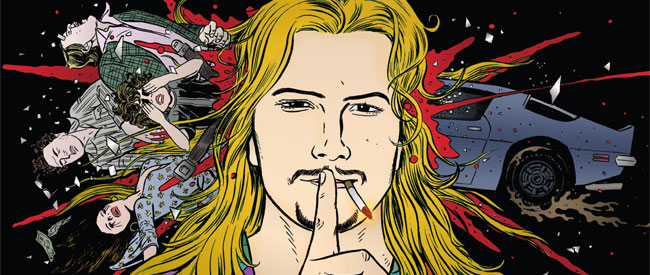
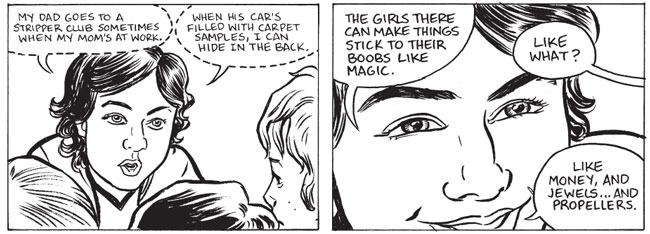
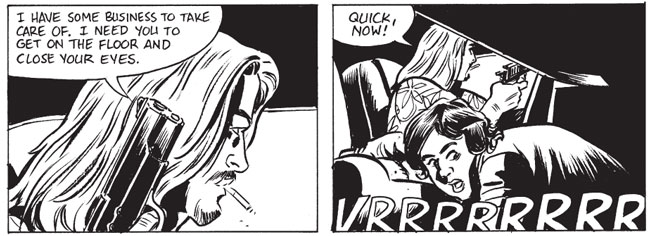
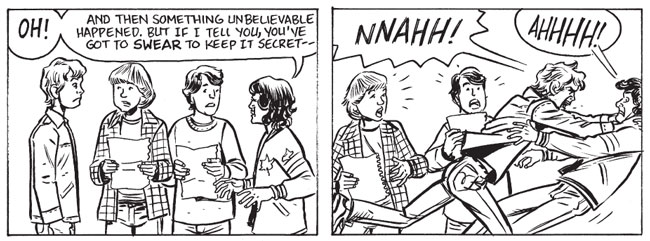
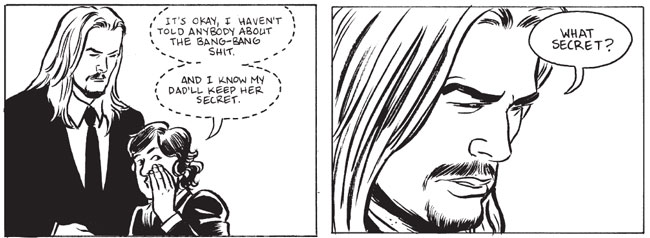
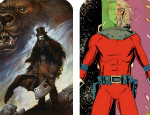
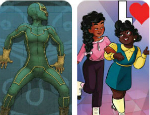
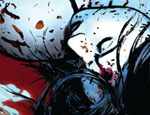

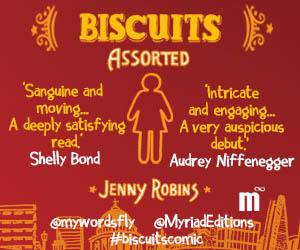





It is truly the best book on the market today. Hasn’t missed a beat in 8 years